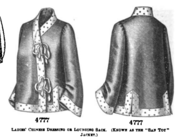
There are typically two types of clothing worn in Japan: traditional clothing known as Japanese clothing, including the national dress of Japan, the kimono, and Western clothing, which encompasses all else not recognised as either national dress or the dress of another country.

Cheongsam or zansae, also known as the qipao and sometimes referred to as the mandarin gown, is a Chinese dress worn by women which takes inspiration from the qizhuang, the ethnic clothing of the Manchu people. The cheongsam is most often seen as a longer, figure-fitting, one piece garment with a standing collar, an asymmetric, left-over-right opening and two side slits, and embellished with Chinese frog fasteners on the lapel and the collar. It was developed in the 1920s and evolved in shapes and design over years. It was popular in China from the 1920s to 1960s, overlapping with the Republican era, and was popularized by Chinese socialites and high society women in Shanghai. Although the cheongsam is sometimes seen as traditional Chinese clothing, the cheongsam continues to evolve with times as it responds to the contemporary modern life.

Chinoiserie is the European interpretation and imitation of Chinese and other East Asian artistic traditions, especially in the decorative arts, garden design, architecture, literature, theatre, and music. The aesthetic of chinoiserie has been expressed in different ways depending on the region. It is related to the broader current of Orientalism, which studied Far East cultures from a historical, philological, anthropological, philosophical, and religious point of view. First appearing in the 17th century, this trend was popularized in the 18th century due to the rise in trade with China and the rest of East Asia.

Diane von Fürstenberg is a Belgian fashion designer best known for her wrap dress. She initially rose to prominence in 1969 when she married into the German princely House of Fürstenberg, as the wife of Prince Egon von Fürstenberg. Following their separation in 1972 and divorce in 1983, she has continued to use his family name.

Fashion design is the art of applying design, aesthetics, clothing construction and natural beauty to clothing and its accessories. It is influenced by culture and different trends, and has varied over time and place. "A fashion designer creates clothing, including dresses, suits, pants, and skirts, and accessories like shoes and handbags, for consumers. He or she can specialize in clothing, accessory, or jewelry design, or may work in more than one of these areas."
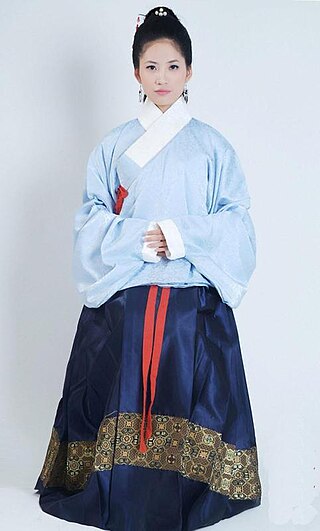
Ruqun is a set of attire in Hanfu which consists of a short jacket typically called ru worn under a long Chinese skirt called qun. However, when use as a general term, ruqun can broadly describe a set of attire which consists of a separated upper garment and a wrap-around lower skirt, or yichang, in which yi means the "upper garment" and the chang means the "lower garment". In a broad sense, ruqun can include the shanqun and aoqun in its definition.
Banbi, also known as banxiu and sometimes referred as beizi or half-beizi before the term beizi eventually came to refer to a long-sleeved beizi in the Song dynasty, and referred as dahu in the Yuan dynasty, is an upper garment item in Hanfu. The banbi is in the form of a waistcoat or outerwear with short sleeves, which could either be worn over or under a long-sleeved ruqun. The style of its collar varies; it can also be secured at the front either with ties or a metal button.
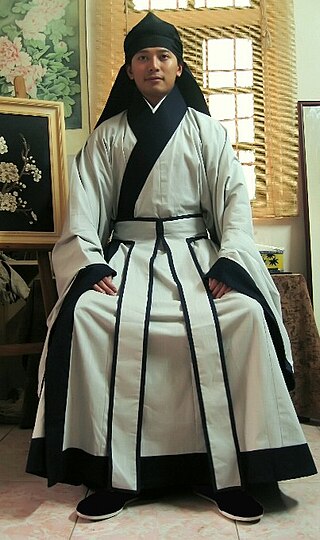
Shenyi, also called Deep garment in English, means "wrapping the body deep within the clothes" or "to wrap the body deep within cloth". The shenyi is an iconic form of robe in Hanfu, which was recorded in Liji and advocated in Zhu Xi's Zhuzi jiali《朱子家禮》. As cited in the Liji, the shenyi is a long robe which is created when the "upper half is connected to the bottom half to cover the body fully". The shenyi, along with its components, existed prior to the Zhou dynasty and appeared at least since the Shang dynasty. The shenyi was then developed in Zhou dynasty with a complete system of attire, being shaped by the Zhou dynasty's strict hierarchical system in terms of social levels, gender, age, and situation and was used as a basic form of clothing. The shenyi then became the mainstream clothing choice during the Qin and Han dynasties. By the Han dynasty, the shenyi had evolved into two types of robes: the qujupao and the zhijupao. The shenyi later gradually declined in popularity around the Wei, Jin, and Northern and Southern dynasties period. However, the shenyi's influence persisted in the following dynasties. The shenyi then became a form of formal wear for scholar-officials in the Song and Ming dynasties. Chinese scholars also recorded and defined the meaning of shenyi since the ancient times, such as Zhu Xi in the Song dynasty, Huang Zongxi in the Ming dynasty, and Jiang Yong in the Qing dynasty.
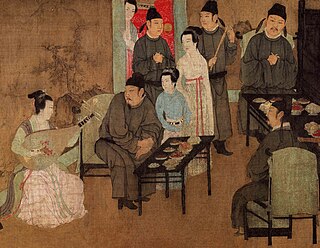
Hanfu, are the traditional styles of clothing worn by the Han Chinese. There are several representative styles of hanfu, such as the ruqun, the aoqun, the beizi and the shenyi, and the shanku.

Zaju chuishao fu, also called Guiyi, and sometimes referred as "Swallow-tailed Hems and Flying Ribbons clothing" or "swallow tail" clothing for short in English, is a form of set of attire in hanfu which was worn by Chinese women. The zaju chuishao fu can be traced back to the pre-Han period and appears to have originated the sandi of the Zhou dynasty; it then became popular during the Han, Cao Wei, Jin and Northern and Southern dynasties. It was a common form of aristocratic costumes in the Han and Wei dynasties and was also a style of formal attire for elite women. The zaju chuishao fu can be further divided into two categories of clothing style based on its cut and construction: the guipao, and the guichang.

Qixiong ruqun, which can also be referred as Qixiong shanqun, also known as "chest-high ruqun", is a set of attire in hanfu, the traditional Chinese clothing worn by the Han Chinese. The qixiong ruqun is a unique style of ruqun, which is characterized with a high waistline qun, Chinese skirt. The qun used in the qixiong ruqun is generally tied above the bust level. It was worn by women during the Southern dynasties, Sui dynasty, Tang dynasty and Five Dynasties and Ten Kingdoms period. The style was also revived in the early and middle Ming dynasty.
The fashion in the Yuan dynasty of Mongol (1271–1368) showed cultural diversity with the coexistence of various ethnic clothing, such as Mongol clothing, Han clothing and Korean clothing. The Mongol dress was the clothing of elite for both genders. Mongol attire worn in the 13th-14th century was different from the Han clothing from the Tang and Song dynasties. The Yuan dynasty court clothing also allowed the mixed of Mongol and Han style, and the official dress code of the Yuan dynasty also became a mixture of Han and Mongol clothing styles. After the founding of the Yuan dynasty, the Mongols strongly influenced the lifestyle and customs of the Han people.

Paofu, also known as pao for short, is a form of a long, one-piece robe in Hanfu, which is characterized by the natural integration of the upper and lower part of the robe which is cut from a single fabric. The term is often used to refer to the jiaolingpao and the yuanlingpao. The jiaolingpao was worn since the Zhou dynasty and became prominent in the Han dynasty. The jiaolingpao was a unisex, one-piece robe; while it was worn mainly by men, women could also wear it. It initially looked similar to the ancient shenyi; however, these two robes are structurally different from each other. With time, the ancient shenyi disappeared while the paofu evolved gaining different features in each succeeding dynasties; the paofu continues to be worn even in present day. The term paofu refers to the "long robe" worn by ancient Chinese, and can include several form of Chinese robes of various origins and cuts, including Changshan,Qipao, Shenyi,Tieli, Zhisun, Yesa.
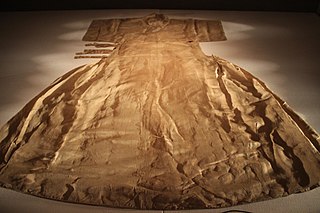
Dahu was a form of robe/jacket which originated in the Ming dynasty. In Ming dynasty, the dahu was either a new type of banbi or a sleeveless jacket, whose designs was influenced by the Mongol Yuan dynasty clothing.

Shanku is a generic term which refers to a two-piece set of attire in Hanfu, which is typically composed of a youren yi, a Chinese upper garment which typically overlaps and closes on the right side which could be called shan, ru, ao, and a pair of long trousers ku. As a form of daily attire, the shanku was mainly worn by people from lower social status in China, such as labourers, shopkeepers, or retainers from wealthy household. The shanku was originally worn by both genders. Up until the mid-20th century, it was popular in China and outside of China where it was worn by overseas Chinese in countries, such as Singapore, Malaysia, Suriname, etc. It is still worn in present-day China and can be found in rural areas.

Hufu, also referred as Hu clothing, nomadic dress, 'barbarian' clothing or dress, or foreign dress, is a generic term which refers to any clothing which was worn in ancient China and its surrounding regions by non-Han Chinese people. This term is also used to refer to clothing of foreign origins in ancient China. The introduction of Hufu-style garments and attire in China occurred by the time of King Wuling of Zhao.

Ru, sometimes referred to as shan, ao, and yi, is a form of traditional Chinese upper garment, or coat, or jacket, which typically has a right closure; however, they may also have a front central opening. It is traditional everyday wear for women of the Han Chinese ethnic group. It can be worn in combination with a skirt in a style called ruqun, or a pair of trousers in a style called shanku.

Tanling ruqun, also known as Tan collar ruqun and U-collar ruqun, is a type of Hanfu which was developed under the influence of Hufu ; it is a form a kind of ruqun which typically consists of three parts, featuring a low-cut low-cut U-shaped collar upper inner garment with long sleeves, a U-shaped collar banbi upper outer garment with short sleeves, a long high-waisted skirt. It can also be adorned with a shawl, called pipo. It was a popular form of clothing attire in the Sui and Tang dynasty. In the 21st century, the Tanling ruqun re-appeared as a result of the Hanfu movement. The 21st century Tanling ruqun was developed by reproducing the original patterns of the historical tanling ruqun while being aligned with modern aesthetics.

Garment collars in hanfu are diverse and come in several shapes, including jiaoling, duijin, yuanling, liling, fangling, tanling. Some forms of collars were indigenous to China while others had been adopted from the Hufu of other non-Han Chinese ethnic minorities and/or from the clothing worn by foreigners.
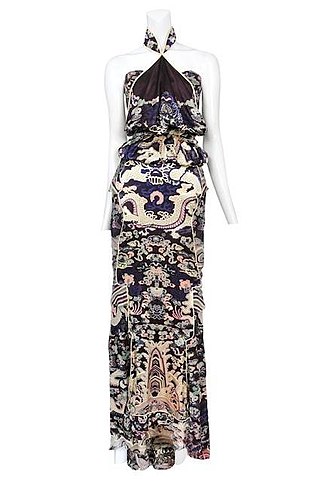
Chinoiserie in fashion refers to the any use of chinoiserie elements in fashion, especially in American and European fashion. Since the 17th century, Chinese arts and aesthetic were sources of inspiration to European artists, creators, and fashion designers when goods from oriental countries were widely seen for the first time in Western Europe. Western chinoiserie was also often mixed with other exotic elements which were not all indigenous to China.







